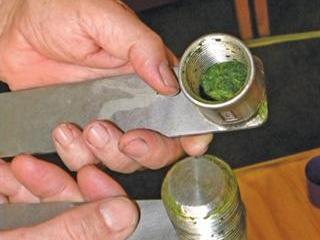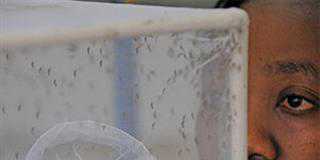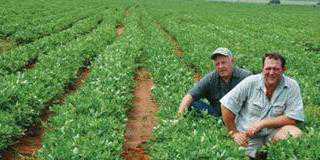
Testing a crop’s Brix levels is a well-known method of checking the sweetness of crops, especially soft fruit, grapes, citrus, tomatoes, vegetables and sugar cane. However, measuring the Brix prior to harvest is only one part of the picture. The method can also be used to measure the health of both the plant and the growing medium, as well as the crop’s response to changes in the growing regimen.
“To measure Brix is a good way of finding out if the plant is growing happily,” says Jeff Joubert, bioagronomy consultant at biological input supplier Biotechnica. “South African farmers generally do not take Brix measurements often enough, but there are good reasons to do so. Fruit with higher Brix levels tastes better and is more nutritious, with lower nitrate and water content and a lower freezing point.
It also has better storage attributes. “If you keep Brix levels as high as possible, the final produce will last longer on the plant and on the shelf. It allows you to extend the picking time or shelf life by 10 to 14 days.”
Tools of the trade
A Brix test (named after its inventor Adolf Brix) is performed with a refractometer, a hand-held manual or electronic instrument which measures the amount of light refracted by sap. The more light that is refracted, the more nutrients and flavours are in the crop – and the higher the Brix measurement.
The refractometer measures all the total dissolved solids (TDS) including soluble minerals, carbohydrates (sugars and starches), amino acids, oils, proteins, flavonoids and minerals. In sweet fruits such as mangoes and pineapples, the sugar content (usually sucrose, glucose or fructose) is the dominant measure.
Brix testing is carried out regularly as part of an agronomic approach on Greenpak farm in Bothaville, a fresh produce supplier to an upmarket retailer. This is in line with the retailer’s sustainable farming initiative. “Regular Brix tests give us a very good indication of the health of the crop. It also helps us determine the quality of the produce, which is an important factor for the retailer,” says Greenpak director Toks Liebenberg.
“For the past few years, we’ve also incorporated bioagronomic methods. Improving the soil structure and chemistry and then introducing beneficial micro-organisms has been key to this. We’re very pleased with the results.”
Using brix to improve crops
Performing a Brix test is simple: a few drops of sap is squeezed from the crop onto the prism of the refractometer, which gives a reading in Brix. Firmer vegetables or fruit, such as cabbage, carrots or pears, may require a garlic press to squeeze the juice into the testing kit. For tougher produce such as pumpkin or sugar cane, a sap squeezer might be needed to extract the juice.
The reading is measured against a Brix chart to see whether it is at the correct level for that particular crop.
“Sap squeezed out of any part of the plant – the leaves, stems, green fruit or roots – can be used for Brix testing,” says Joubert. It is vitally important, however, to be consistent when taking the measurements. “Brix doesn’t remain constant throughout the day,” explains Joubert. “Ripeness and soil fertility are important contributors but Brix can also be affected by temperature, sunlight, frost, rainfall or irrigation. In addition, samples should always be taken from the same part of the plant.
And ideally, the same person should perform all the Brix testing to help to ensure consistency. “In this way, a producer can build up a body of data to help fine-tune the crop management programme.” For larger fruits such as pawpaw, pineapples and melons, the Brix level can vary quite considerably throughout the fruit itself. For example, the side of the fruit that is more exposed to the sun will deliver a different reading to the other side. Thus, a grower may have to take two or three readings from various parts of the fruit.
Brix measuring can change the way producers grow their plants by rapidly showing the effect of adjustments to crop management on quality and taste. These include changes to irrigation frequency and timing, fertiliser timing and application, and foliar sprays. “Check the juice a few hours and days after you’ve made a change to check if it is to the crops’ liking,” explains Joubert.
“If the change is not working, there’s still time to correct it before the crop matures. “If, for example, the Brix level does not rise in response to a foliar feed, it is likely that the foliar combination is not the right mixture for the plant at that time.”
How to grow high-Brix crops
The foundation of high-Brix farming lies in the soil. A programme that develops fertile and balanced soil, rich in beneficial soil microbes, produces nutrient-dense crops. Biotechnica suggests the following approach for growing high-Brix crops:
Source: Biotechnica |
Contact Biotechnica on 031 792 9860. Alternatively, contact Jeff Joubert on 082 880 4898, email [email protected], or visit www.biotechnica.co.uk. For more details on the sap squeezer on page 34, contact Nick Snaith of East Coast Organics on 082 654 0364 or email [email protected].
Sources:
1) http://www.granitenet.com.au/groups/environment/certified-naturally-farmed-granite-belt;
2) www.agriculturesolutions.com/Resources/The-Brix-Movement-Growing-For-Quality.html;
3) www.westonaprice.org/farm-a-ranch/nutrient-dense-food-high-brix-farming-gardening













